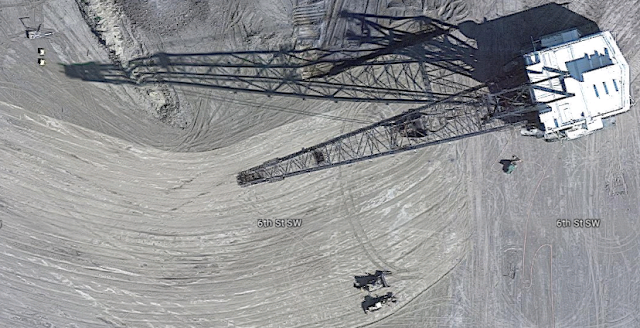Dragline East: (Satellite) "Chief Ironsides"
Dragline South: (Satellite) "Prairie Rose"
The mine and power plant were sold to Rainbow Energy in 2022 because it was losing money.
 |
| Thomas Kagerbauer posted "CHIEF IRONSIDE" got a bit of an overhaul in 2022. Dennis DeBruler: My research indicates that Chief Ironside works east of Underwood, https://www.google.com/.../@47.4809135.../data=!3m1!1e3... [the satellite links are at the top of these notes] rather than south of Underwood, https://www.google.com/.../@47.3285303.../data=!3m1!1e3... Does the second dragline have a name? Thomas Kagerbauer: Dennis DeBruler You are right with Underwood. The second one is called "Prairie Rose" |
If I remember correctly, North Dakota coal is lignite, so I looked for the mine-mouth power station. I found it.
 |
| RainbowEnergyCenter A high-voltage direct current (HVDC) transmission line is used to deliver the power to a converter station near Buffalo, MN. [I knew HVDC was being developed for offshore wind turbines. I did not know that it was being used for transmission across land.] |
"Units and In-Service Dates: Unit 1: 604.8 MW (1979), Unit 2: 604.8 MW (1980)" Rainbow Energy claims they are going to add carbon capture. [gem]
The DOE is going to try again to make carbon capture work. This time with $38m. "North Dakota contains the world’s largest known deposit of lignite and it is the fifth largest coal-producing state in the country." [kfyrtv]
gem stated that the EPA "proposed the refusal of applications from six coal-fired power stations to dispose of coal ash in unlined dams. The EPA stated that the utilities operating the power stations failed to demonstrate how they would meet groundwater protection regulations." But inforum says that the EPA "proposes to deny a permit for a liner [my emphasis] for Rainbow Energy Center." That is, the power plant wants to fix its waste storage ponds, but the EPA is denying it. They would have to shut down for three years to build a new ash disposal system. So would the other five coal-powered plants.
"If that [3-year shutdown] were to happen, the Midwest power grid would lose the 8 million megawatts of electricity the plant generates each year, according to John Weeda, director of the North Dakota Transmission Authority." [inform] Did the reporter incorrectly understand Mr. Weeda, or did the director of the North Dakota Transmission Authority use the unit megawatts instead of the correct unit of megawatthours?
.webp) |
| GrandForksHerald, photo provided by the North Dakota Lignite Council The bulk of the fly ash is collected and used in cement. [I've been wondering what the cement industry is going to use for ash after all of the coal-fired plants are shutdown. Fly ash not only reduces CO2 because making cement is very carbon intensive, but it also makes the concrete stronger. Fly ash emulates the secret ingredient that the Romans used, namely volcanic ash. Making cement is carbon intensive for two reasons. One is that a lot of fuel has to be burned to create the very high kiln temperatures needed to reduce the raw materials. Two is the chemical reaction itself. Carbon is removed from the raw materials by combining with oxygen and becoming CO2. [Dennis DeBruler]] |
.webp) |
| GrandForksHerald, photo provided by the North Dakota Lignite Council The article talks about carbon capture as well as fly ash disposal. "Dakota Gas, located in Beulah, has been capturing carbon and sending it to Canada for enhanced oil recovery for decades, he said. Minnkota is working on Project Tundra, a large-scale facility that aims to capture carbon for storage. The Energy & Environmental Research Center at the University of North Dakota in Grand Forks does much in the way of research to create and improve systems. He listed other projects, noting all of which ultimately help North Dakota enhance its energy and environmental efforts." |
 |
| Satellite |
 |
| 1 of 3 photos posted by Secretary Rick Perry Falkirk’s Chief Ironsides dragline is a 124 cubic yard dragline, which is one of the largest walking draglines in the world at 214 feet tall, producing 13,000 horsepower, and weighing over 13 million pounds. @ Falkirk Mining Company |
Note the Chief Ironsides logo in the upper-left corner of the house. This 2010 crossing together with the Google Earth images below allowed me to determine that the eastern dragline is Chief Ironsides.
 |
| Chief_Ironside_crosses_Hwy_83_Jan_26_2010.jpg via agtalk |
Five months before they moved Chief Ironsides, we see it near the middle of the strip that is south of Underwood.
 |
| Google Earth, Aug 2009 |
Ten months after the move, it is in the new strip east of Underwood. And we can see the landscar of the road they built for the move. Note that they went South and then back North so that they could cross where the railroad and road were close to each other.
 |
| Google Earth, Dec 2010 |
.webp) |
| TheDickinsonPress, Submitted Photo of Katie Humphrey The two operators were able to exist safely. [This article about a bench failure in 2015 confirms that Chief Ironsides works in the East Mine.] |
The dragline was running again just five days later. [NewsJournal]
.jpg) |
| eenews, Photo by Daniel Cusick The dragline removes up to 65' (20m) of overburden to expose a 10' (3m) seam of lignite. By May 2017, Basin Electric Power Cooperative was already producing more power from wind, 1.3gw, than this power station can produce. And Basin planned to add 300 to 400 MW by 2019. |
Chief Ironsides in operation.
 |
| 8:39 video @ 0:21 Riding on the Chief Ironsides, a massive 14.5 million pound Dragline. |

No comments:
Post a Comment